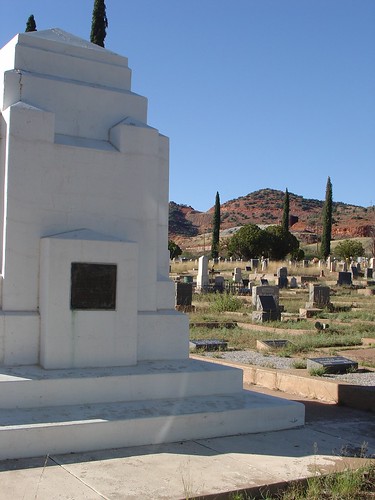 |
| George Warren By Unknown, published by S.J. Clarke Publishing Company [Public domain], via Wikimedia Commons |
A few photos exist of George Warren since the photographer Camillus Sydney Fly would visit Bisbee and take photos of the miners as they collected their pay. The man on The Great Seal of the State of Arizona is based on one of Fly's photos of George Warren.
George Warren was talked into staking a mining claim by Lt. John Rucker and a man named Ted Byrne after a scout, Jack Dunn, found a good place to mine while looking for a water source. Their only requirement was for Warren to use Dunn's name on all mining claims. George Warren didn't stick by his agreement and got drunk and gambled away the mining stake. Later on, he would get backers to stake new claims. Which would lead to the creation of the Warren Mining District. He also held an interest in the Copper Queen Mine at this time.
George Warren had two serious injuries from fights. He was also known to be a heavy drinker. Once, in a duel, he was shot in the neck. Another time, he was shot in the arm and the leg and he survived both incidents. In other words, he was one tough 'son-of-a-bitch'.
| Stories about George Warren, other individuals, and the history of Arizona are presented in this book in the form of poetry. |
In May of 1881, the scheming Atkins had a Cochise County Judge, J.H. Lewis, declare George Warren insane and had him held in an institution in California (possibly for a few years). A man named George Praidham became Warren's guardian and Praidham was ordered to sell the rest of Warren's assets. He sold them for $923 at an auction. Warren was released a while after the sale and only learned about the sale after the release.
George Warren, after finding out about the sale, took off to Mexico to begin mining. In 1885, he discovered a mining claim and had to become a Mexican citizen to take the claim. He went into servitude, working as an interpreter for a Mexican judge, to help pay off a debt of $40. A judge back named G.H. Berry, learned about Warren and his debt, so he paid off Warren's debt for him. Warren then came back to Bisbee after the debt was paid. Once back, Warren worked as a blacksmith and tool dresser while also receiving a small pension from the Copper Queen Mining Company.
His work as a blacksmith and tool dresser didn't last that long. His alcoholism caught up with him and he was little more than what would be considered a janitor, only worse. He was looked down upon by the miners and swept floors and cleaned the chewing tobacco spitting bowls (aka cuspidors) for drinks of whiskey. His lifestyle was little more than that of a rounder, someone who lives for the drink, by this time.
He was mostly forgotten until 1914 when the Bisbee Elk's Lodge wanted to put a monument over his grave. They located George Warren's grave, which was likely hard to find since the wooden grave marker was probably gone, and they had him reinterred to a better location in the cemetery. Over his new gravesite, the large monument was put in place. It features the a C.S. Fly's image of him and an inscription, "George Warren Born unknown Died 1892 Poor in Purse, Rich in Friends."
His grave, and the monument, are still present at the Evergreen Cemetery in Bisbee, Arizona.


